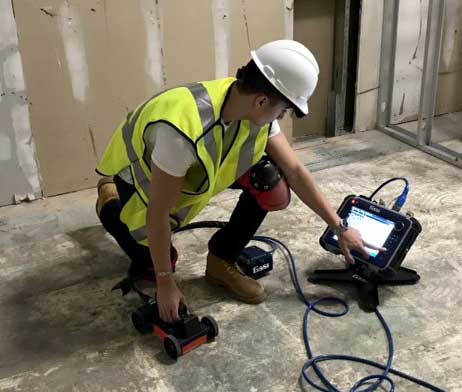Why Choose RainierGPR Concrete Scanning for Accurate Subsurface Evaluation
Why Choose RainierGPR Concrete Scanning for Accurate Subsurface Evaluation
Blog Article
Discovering the Key Benefits of Concrete Scanning in Building And Construction Projects
In the world of modern construction methods, the utilization of concrete scanning technology has become a pivotal tool for ensuring task effectiveness and architectural honesty. From boosting safety and security steps to accurately identifying utilities concealed below the surface, the advantages of concrete scanning are diverse. The capacity to improve project timelines and minimize expenses while maintaining existing frameworks is a testimony to the value this technology offers the construction market. As we explore the nuanced advantages of concrete scanning, it becomes noticeable that its effect extends much beyond surface-level evaluations, providing a look right into the intricate internet of advantages waiting to be discovered.
Enhanced Safety Procedures
Using innovative concrete scanning technology boosts precaution on construction sites by giving exact discovery of potential hazards concealed under the surface. This modern technology makes it possible for construction groups to determine rebar, avenues, post-tension cords, and various other obstructions before excavation or drilling, considerably reducing the risk of crashes. By determining these aspects precisely, workers can prevent harmful crucial architectural parts, thus stopping injuries, delays, and expensive repair services.
Additionally, concrete scanning plays a vital function in making sure the stability of existing structures throughout growths or remodellings. By discovering weak points, voids, or degeneration within concrete components, designers can resolve these problems proactively, enhancing the general safety and security and longevity of the building. This aggressive strategy not only mitigates the risk of architectural failings but likewise reduces the capacity for accidents triggered by unexpected structural shortages.
Basically, the implementation of concrete scanning technology functions as a proactive safety and security procedure that safeguards both building workers and the structural integrity of structures, ultimately contributing to the total success and efficiency of building tasks. - RainierGPR Concrete Scanning
Accurate Detection of Utilities
Concrete scanning technology helps with specific recognition of underground utilities, boosting building website safety and effectiveness. Exact discovery of utilities is crucial in construction tasks to stop pricey damages, task hold-ups, and most notably, make certain the security of workers and the general public. By using sophisticated scanning technologies such as ground-penetrating radar (GPR) and electro-magnetic induction, building and construction teams can map out the location of hidden pipelines, cables, and various other energies with high degrees of precision.

Time and Expense Effectiveness

Concrete scanning modern technology enables construction groups to accurately situate rebar, post-tension wires, and various other embedded items within concrete frameworks. This specific info helps in preventing costly mistakes such as unintentional damages to critical elements throughout drilling, cutting, or coring tasks. In addition, by determining potential dangers ahead of time, the need for pricey repair work or revamp due to damages can be minimized, resulting in set you back financial savings for the task.
Moreover, the ability to promptly and precisely discover energies beneath the surface area without causing any damages not only saves time yet also avoids costly disturbances to existing framework. In general, the time and expense effectiveness advantages of concrete scanning make it an indispensable tool for boosting construction project administration and execution.
Preservation of Architectural Stability
Preserving the structural stability of buildings and facilities is critical in making certain long-lasting stability and safety. Concrete scanning plays an important role in this conservation process by allowing building specialists to identify prospective hazards to the architectural honesty of more information a structure or framework before they escalate right into major concerns. Via the use of advanced scanning technologies such as ground-penetrating radar (GPR) and electro-magnetic induction, building teams can non-invasively examine the problem of concrete frameworks, locate rebar, post-tension cable televisions, and other ingrained components, and recognize any type of voids, cracks, or degeneration within the concrete.
Improved Job Preparation
In order to ensure the successful implementation of construction projects, meticulous focus to detail and complete preparation are necessary parts that stem from a detailed understanding of the architectural problems identified via concrete scanning. Eventually, incorporating concrete scanning into the job planning stage boosts coordination amongst group participants, fosters aggressive analytical, and contributes to the successful shipment of building and construction jobs within budget and routine constraints.
Conclusion
To conclude, concrete scanning uses various advantages in building tasks. By improving security procedures, precisely spotting utilities, improving time and price performance, protecting architectural honesty, and assisting in task preparation, concrete scanning verifies to be an essential tool for effective project implementation. Its ability to alleviate dangers, boost effectiveness, and guarantee job integrity makes it an important property for building experts.
In the realm of modern construction practices, the utilization of concrete scanning modern technology has actually emerged as a pivotal device for ensuring job efficiency and structural integrity.Concrete scanning technology makes it possible for construction groups get redirected here to accurately situate rebar, post-tension wires, and various other ingrained things within concrete frameworks. With the use of sophisticated scanning technologies such as ground-penetrating radar (GPR) and electro-magnetic induction, building and construction groups can non-invasively evaluate the condition of concrete frameworks, situate rebar, post-tension cords, and other ingrained elements, and recognize any voids, cracks, or deterioration within the concrete.
In order to guarantee the effective execution of construction jobs, careful focus to detail and comprehensive preparation are vital parts that stem from a detailed understanding of the architectural conditions determined through concrete scanning. Inevitably, including concrete scanning right into the job planning phase boosts coordination amongst group members, fosters positive analytic, and contributes to the effective delivery of building jobs within spending plan and schedule constraints.
Report this page